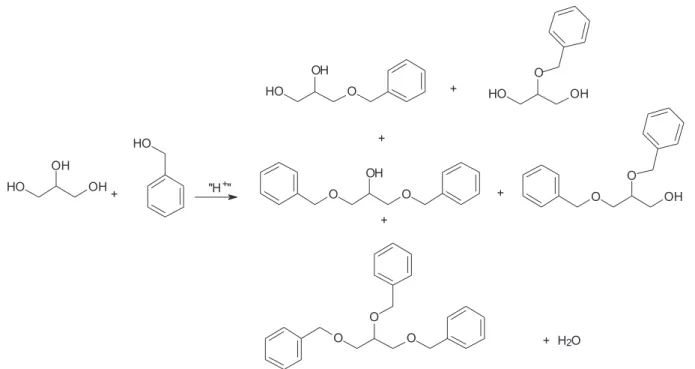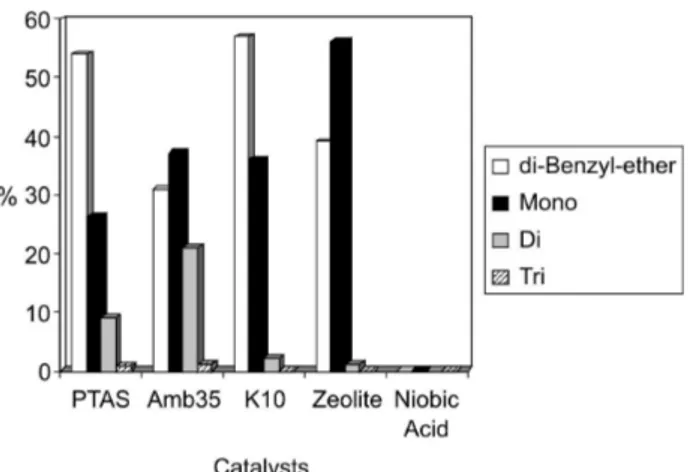C
o
m
m
u
ni
c
a
ti
o
n
J. Braz. Chem. Soc., Vol. 20, No. 2, 201-204, 2009. Printed in Brazil - ©2009 Sociedade Brasileira de Química 0103 - 5053 $6.00+0.00
*e-mail: cmota@iq.ufrj.br
Etherification of Glycerol with Benzyl Alcohol Catalyzed by Solid Acids
Camila R. B. da Silva, Válter L. C. Gonçalves, Elizabeth R. Lachter and Claudio J. A. Mota*
Instituto de Química, Universidade Federal do Rio de Janeiro, Cidade Universitária, Av. Athos da Silveira Ramos 149, CT Bloco A, 21941-909 Rio de Janeiro-RJ, Brazil
Neste trabalho apresentamos os resultados da eterificação do glicerol com álcool benzílico, catalisada por diferentes sólidos ácidos. O mono-éter benzílico do glicerol foi o produto principal nas reações com a zeólita β e a resina ácida Amberlyst-35. Já o éter-di-benzílico foi o produto majoritário nas reações com o ácido p-tolueno-sulfônico e a argila K-10 como catalisadores. O ácido nióbico foi inativo na reação. A estrutura porosa da zeólita impediu a formação significativa de produtos de di e tri eterificação.
In this work we present the results of glycerol etherification with benzyl alcohol, catalyzed by different solid acids. The mono-benzyl-glycerol ether was the main product in the reactions catalyzed by β zeolite and Amberlyst-35 acid resin, whereas di-benzyl-ether was formed in higher yield with the use of p-toluene-sulfonic acid and K-10 montmorillonite as catalyst. Niobic acid was inactive in this reaction. The porous structure of the zeolite impaired the formation of di and tri-benzyl-glycerol ethers.
Keywords: glycerol, solid acids, etherification
Introduction
The concern about global warming, due to the use of fossil fuels, has motivated the debate about biofuels, produced from biomass materials. Among them, biodiesel appears as one of the most promising and is normally produced through the transesterification of vegetable oils or animal fat with methanol.1 This reaction is usually
carried out under alkaline catalysis conditions, affording methyl esters of fatty acids, the biodiesel themselves, and glycerol.
One of the most important challenges of the biodiesel production is the destination of the glycerol formed. According to recent projections,2 the world glycerol
production would reach 1.2 million tons in 2010, due to the increasing use of biodiesel. This forecast affects the price of glycerol and of the biodiesel as well, because the producers have to find a destination for the glycerol.
The main use of glycerol is in personal care and cosmetics, but its use as a valuable feedstock for new products and processes is growing in importance; some reviews about it have appeared in the literature.2-4
The catalytic hydrogenation of glycerol to 1,2 and
1,3-propanediol5-7 might become an industrial process in a
near future, as some major chemical companies announced8
the interest in building commercial plants of this process. Glycerol reforming to syn gas9 is also a potential economic
process, which might be coupled with Fischer-Tropsch type catalysts,10 to yield gasoline range hydrocarbons.
Yet, glycerol might be blended with vacuum gasoil for processing in catalytic cracking units.11
Many of the previous applications may require further developments or might be restricted to some particular conditions of the glycerol supply. Therefore, the search for other applications, especially involving less time demanding technologies, is still needed.
Glycerol ethers have many potential uses, such as fuel additives,12 solvents,13 cryogenics,14 and anti-bacterial
agents.15 Reactions of glycerol with isobutene16 or
tert-butanol17 under acid catalysis conditions afford
tert-butyl-glycerol ethers, which have potential for blending with diesel.18 Recently, Gu et al.19 reported the etherification
Etherification of Glycerol with Benzyl Alcohol Catalyzed by Solid Acids J. Braz. Chem. Soc. 202
acid catalysts, aiming to produce mono, di and tri benzyl glycerol ethers (Scheme 1).
Experimental
Reactions were carried out in batch mode, using 5.0 g (54 mmol) of glycerol, 17.5 g (162 mmol) of benzyl alcohol and 0.5 g of the pre-treated catalyst. The system was kept at a controlled temperature and continuously purged with nitrogen, to carry away the water molecules formed in the reaction. The products were analyzed by gas chromatography and, in some cases, by gas chromatography coupled to a mass spectrometer.
The catalysts used were Amberlyst 35 (Rohm and Haas), zeolite β (Zeolyst), K-10 montmorillonite (Fluka), niobic acid (CBMM) as well as p-toluene-sulfonic acid (PTSA) for comparison with a homogeneous system. Table 1 shows the pre-treatment conditions and Table 2 reports characterization and acidity data of the heterogeneous catalysts.
Results and Discussion
Figure 1 shows the product distribution of the acid-catalyzed reaction between glycerol and benzyl alcohol at 110 oC and 120 min of reaction time. One can see that
PTSA and K-10 montmorillonite favors the formation of di-benzyl ether, arisen from the self-etherification of benzyl alcohol, relative to the benzyl-glycerol ethers. The yield of the mono-benzyl-glycerol ether was higher over the K-10 catalyst compared with PTSA. Self-etherification of benzyl alcohol may be explained by the 3:1 molar ratio of benzyl alcohol to glycerol used in this study, whereas Gu et al. 19 used a ratio of 1:1 and apparently did not find
self-etherification. Except for the niobic acid, all reactions showed 100% glycerol conversion.
Amberlyst-35 and zeolite β showed a superior performance than the other catalysts, producing the glycerol benzyl ethers in higher yield than the di-benzyl
Table 1. Pre-treatment conditions of the heterogeneous catalysts
Catalyst Pre-treatment Temperature/(oC)
time/conditions
Amberlyst-35 105 (10 oC min-1) Overnight/vacuum Zeolite β 400 (10 oC min-1) One hour
Niobic Acid 300 (5 oC min-1) Three hours
K-10 110 (10 oC min-1) One hour
Table 2. Surface areas and acidity of the catalysts
Catalyst Área/
(m2 g-1)
Si/Al Aciditya/ (mmol n-butilamine g-1)
Amberlyst-35 50 - 5.2b
K-10 240 6.6 0.5
Niobic Acid 187 - 0.3
H-β Zeolite 633 16 1.6
aMeasured21 by n-butylamine adsorption at 150 oC; bInformed by the producer.
da Silva et al. 203 Vol. 20, No. 2, 2009
ether. The zeolite showed the best selectivity to the mono-benzyl-glycerol ether among the catalysts tested. In fact, the selectivity to the di and tri-benzyl-glycerol ethers was very low over the zeolite catalyst. This might be associated with the shape selectivity property20 of zeolites, which
impairs the formation of bulk transition states. Thus, the pore structure of zeolite β may not accommodate the transition state for a second or third benzylation of glycerol. Therefore, zeolite β might be used as a good catalyst to produce the mono-benzyl-glycerol ether, with little or no formation of the di and tri-benzyl ethers.
Niobic acid was practically inactive toward the reaction, even at longer reaction times. This might be associated with its lower acidity, compared to the other catalyst tested, not only related with respect to total acidity, but also to the acid strength. We have recently published21 a study on the
use of linear free energy relationship to estimate the acid strength of different solid acids and Niobic acid was the weakest solid acid material tested, in agreement with its poor catalytic activity. On the other hand, Amberlyst-35 and zeolite β presented the highest acidity among the catalyst tested and were more selective toward the formation of the benzyl-glycerol ethers. This might suggest that acidity plays an important role in the reaction.
A surprising fact was the high activity of K-10 montmorillonite. Despite of this catalyst does not present a high acidity, it produced the benzyl-glycerol ethers in good yield, although di-benzyl ether was the main product. In studies22 of glycerol acetylation with
acetic acid this catalyst presented high activity as well, comparable to the activity of an acid exchange resin. It is not completely clear why K-10 montmorillonite performs well in these reactions, but a possible explanation is that its structure would be capable of adsorbing the water
formed, probably shifting the equilibrium or preventing catalyst deactivation.
In the benzylation of anisole with benzyl alcohol catalyzed by clays,23 ion exchange resins24 and alumina25
the dibenzyl-ether was also observed, together with the alkylation product. Deshpande et al.26 reported that
etherification is faster than alkylation over K-10 modified with SbCl3 and that ether formation can be associated to both, Brønsted and Lewis acid sites. This might explain the selectivity pattern for K-10, Amberlyst-35 and zeolite
β, as the last two catalysts have mostly Brønsted acidity, whereas K-10 normally present significant concentration of Lewis acid sites.
Conclusions
The etherification of glycerol with benzyl alcohol can be achieved with the use of heterogeneous acid catalysts. In all cases, self-etherification of benzyl alcohol was also observed. Over zeolite β and Amberlyst-35 the mono-benzyl-glycerol ether was the main product formed, whereas over K-10 montmorillonite and PTSA the di-benzyl ether was formed in higher yield than the glycerol benzyl ethers. Niobic acid was inactive toward the reaction. Zeolite β was the best catalyst for the production of the mono benzyl-glycerol ether, probably due to its shape selective properties, that impairs the formation of the other bulkier ether derivatives.
Acknowledgments
Authors thank FINEP, CNPq and FAPERJ for financial support.
References
1. Pinto, A C.; Guarieiro, L. N.; Resende, M. J. C.; Ribeiro N. M.; Torres, E. A; Lopes, W. A.; Pereira, P. A D.; De Andrade J. B.; J. Braz. Chem. Soc.2005, 16, 1313.
2. Zhou, C. H.; Beltramini, J. N.; Fan, Y. X.; Lu, G. Q.; Chem. Soc. Rev. 2008, 37, 527.
3. Behr, A.; Eilting, J.; Irawadi, K.; Leschinski, J.; Lindner, F.; Green Chem.2008, 10, 13.
4. Pagliaro, M.; Ciriminna, R.; Kimura, H.; Rossi, M.; DeLLa Pina C.; Angew. Chem. Inter. Ed. 2007, 46, 4434.
5. Dasari, M. A.; Kiatsimkul, P. P.; Sutterlin,W. R.; Suppes, G. J.; Appl. Catal. A2005, 281, 225.
6. Kusunoki, Y.; Miyazawa, T.; Kunimori, K.; Tomishige, K.; Catal. Commun. 2005, 6, 645.
7. Miyazawa, T.; Kusunoki, Y; Kunimori, K.; Tomishige, K.; J. Catal.2006, 240, 213.
Etherification of Glycerol with Benzyl Alcohol Catalyzed by Solid Acids J. Braz. Chem. Soc. 204
8. McCoy, M.; Chem. Eng. News 2007, 85, 9.
9. Soares, R. R.; Simonetti, D. A.; Dumesic, J. A.; Angew. Chem. Int. Ed. 2006, 45, 3982.
10. Simonetti, D. A.; Rass-Hansen, J.; Kunkes, E. L.; Soares, R. R.; Dumesic, J. A.; Green Chem.2007, 9, 1073.
11. Corma, A.; Huber, G. W.; Sauvanaud, L.; O`Connor, P.; J. Catal. 2007, 247, 307.
12. Mota, C. J. A.; Gonçalves, V. L. C.; Brazilian Patent PI 0700063-4, 2007.
13. Queste, S.; Bauduin, P.; Touraud, D.; Kunz, W.; Aubry, J. M.; Green Chem.2006, 8, 822.
14. Koshchii, S. V.; Russ. J. Appl. Chem. 2002, 75, 1434. 15. Haynes, M. P.; Buckley, H. R.; Higgins, M. L.; Pieringer, R.
A.; Antimicrob. Agents Chemother.1994, 38, 1523.
16. Karinen, R. S.; Krause, A. O. I.; Appl. Catal. A 2003, 306, 128.
17. Klepacova, K.; Mravec, D.; Bajus, M.; Appl. Catal. A2005, 294,141.
18. Wessendorf, R.; Erdoel & Kohle Erdgas Petrochemie1995, 48, 138.
19. Gu, Y.; Azzouzi, A.; Pouilloux, Y.; Jerome, F.; Barrault, J.; Green Chem. 2008, 10, 164.
20. Smit, B.; Maessen, T. L. M.; Nature2008, 451, 671.
21. Gonçalves, V. L. C.; Rodrigues, R. C.; Lorençatto, R.; Mota, C. J. A.; J. Catal.2007, 248, 158.
22. Gonçalves, V. L. C.; Pinto, B. P.; Silva, J. C.; Mota, C. J. A.; Catal. Today 2008, 133, 673.
23. Yadav, G. D.; Thorat T.S.; Khumbar, P. S.; Tetrahedron Lett. 1993, 34, 529.
24. da Silva, M. S. M.; da Costa, C. L.; Pinto, M. M.; Lachter, E. R.; React. Funct. Polym. 1995, 25, 55.
25. de la Cruz , M. H.C.; Abdel-Rehim, M. A.; Rocha, A. S.; da Silva, J. F.C.; Faro Jr., A. C.; Lachter,E. R.; Catal. Comm. 2007, 8, 1650.
26. Deshpande, A.B.; Bajpai, A.R.; Samant, S.D. ; Appl. Catal., A. 2001, 209, 229.
Received: July 29, 2008

